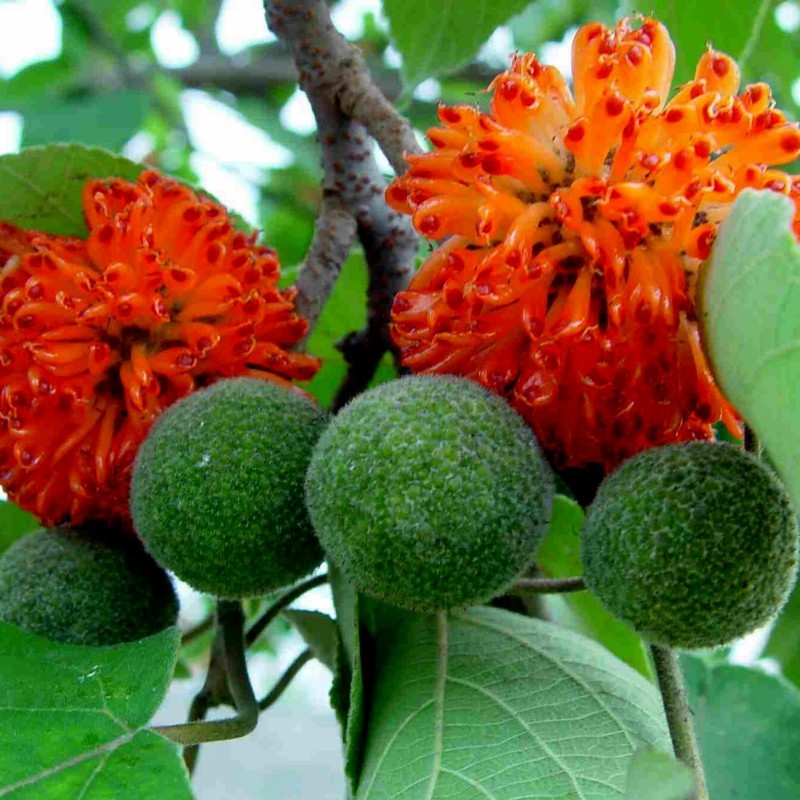
Roślina lecznicza lub przyprawowa

Roślina odporna na zimno i mróz








The paper mulberry (Broussonetia papyrifera, syn. Morus papyrifera L.) is a species of flowering plant in the family Moraceae. It is native to Asia, where its range includes China, Japan, Korea, Laos, Cambodia,
The paper mulberry (Broussonetia papyrifera, syn. Morus papyrifera L.) is a species of flowering plant in the family Moraceae. It is native to Asia, where its range includes China, Japan, Korea, Laos, Cambodia, Thailand, Burma, and India. It is widely cultivated elsewhere and it grows as an introduced species in parts of Europe, the United States, and Africa. Other common names include tapa cloth tree.
Description
This species is a deciduous shrub or tree usually growing 10 to 20 meters tall, but known to reach 35 meters at times. The leaves are variable in shape, even on one individual. The blades may be lobed or unlobed, but they usually have toothed edges, lightly hairy, pale undersides, and a rough texture. They are up to about 15 to 20 centimeters long. The species is dioecious, with male and female flowers on separate plants. The staminate inflorescence is a catkin up to 8 centimeters long with fuzzy male flowers. The pistillate inflorescence is a spherical head up to about 2 centimeters wide with greenish female flowers trailing long styles. The infructescence is a spherical cluster 2 to 3 centimeters wide containing many red or orange fruits. Each individual protruding fruit in the cluster is a drupe.
Uses
This plant has been cultivated in Asia and some Pacific Islands for many centuries for food, fiber, and medicine. It is a significant fiber crop in the history of paper. It was used for papermaking in China by around 100 AD. It was used to make washi in Japan by 600 AD. Washi, a Japanese handcrafted paper, is made with the inner bark, which is pounded and mixed with water to produce a paste, which is dried into sheets.
Tapa cloth is a textile made from the inner bark in many Pacific Island nations. It was the main material for clothing in places such as Fiji, Tonga, Samoa and Tahiti until recent times, and it is still worn ceremonially. It is also used to make bags and bedding.
The wood of the plant is useful for making furniture and utensils, and the roots can be used as rope.
The fruits and cooked leaves are edible.
The fruit, leaves, and bark have been used in systems of traditional medicine. For example, the bark and fruit of the species, known locally as jangli toot, are used as a laxative and antipyretic in rural Pakistan.
The species is used as an ornamental plant. It tolerates disturbance and air pollution, so it has been useful as a landscaping plant on roadsides. It is a pioneer species that easily fills forest clearings, and it has been considered for reforestation efforts. It grows well in many climate types.
Impacts
The ability of the plant to readily colonize available habitat, particularly disturbed areas, has helped it become an invasive species in some regions. It spreads rapidly when male and female individuals grow together and seeds are produced. Seed dispersal is accomplished by animals that eat the fruits, and the plants can form wide, dense stands via their spreading root systems.
This is considered to be one of the worst weeds in Pakistan, one of the most significant invasive plants on the Pampas in Argentina, and a dominant invasive in the forests of Uganda.
The pollen is allergenic. It is reportedly a main culprit of inhalant allergy in Islamabad, where the species is a very common urban weed.
Opis